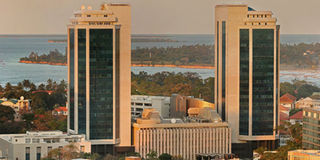Give us special treatment, urge community banks

What you need to know:
Where a community bank operates, the commercial banks can also do business and compete with the former.
Dar es Salaam. Operations of community banks are limited to a specific location while the commercial ones enjoy unlimited market in Tanzania.
Where a community bank operates, the commercial banks can also do business and compete with the former.
However, the regulation of the two is not separated in some aspects despite the differences in capital muscles and markets; the factors that even influence ability to quickly cope with technological changes which require new systems to integrate their traditional banking with digital, online and mobile banking.
The operators of the community banks think it’s time they were given special treatment in some regulatory aspects.
Some of the regulatory issues are in the minimum capital requirements also known as capital adequacy ratios (CARs).
For instance, the Banking and Financial Institutions Regulations require a bank or a financial institution to maintain a minimum core capital of not less than 12.5 per cent of its total risk-weighted assets and off balance sheet exposure; and a total capital of not less than 14.5 per cent of the same.
These are technical measures imposed by the regulators to determine ability of a particular bank to absorb losses.
Similar to the airbag installed in a car to protect users in accidents, these are also imposed to a bank to safeguard depositors and promote the stability and efficiency of financial systems around the world.
However, the concern for the community banks is being measured using the same ratios as commercial banks.
“Existing regulations that also govern all banks as regulated and supervised by the Bank of Tanzania should have exceptions and special consideration for community banks. If you compare sizes, nature, location and market of Community banks and Commercial Banks, then there should be a special consideration for community banks,” says the executive secretary of Tanzania Association of Microfinance Institutions (Tamfi), Ms Winnie Terry.
Community banks have their own association but some of them are also members of Tamfi. “It’s unfair to put commercial banks in the same group of regulation as the commercial banks which have bigger capital and have a wider market in the country,” says the Community Banks Association of Tanzania chief executive officer Mr Senkoro Rukwaro.
He thinks they can be given lower ratios considering their thin capitals and markets.
Another regulatory requirement is for all banks to publish their financial statements in a widely circulating newspaper regardless of the operating locations.
“The requirement to publish statement in a widely circulating newspaper is costly to community banks. If our operations are limited to a specific region, why should we publish our financials in national newspapers which are very expensive? Why are we not allowed publishing in the public platforms available in those areas? It can be in notice boards of the district councils, schools and others within the areas of operations,” he says.
The Community Banks Association of Tanzania has 10 members which are present in different regions of the country.
Tanzania has 12 community banks, 41 fully fledged commercial banks, three financial institutions and four deposit-taking microfinance banks.
There are also two private credit reference bureaus and three financial leasing companies, according to the directory of banks and financial institutions available on the Bank of Tanzania (BoT) website.
All banks and financial institutions are supervised by the BoT to ensure they conduct their business on a sound prudential basis and according to the various laws and regulations in force. The central bank also supervises the banking conduct and the licensing of financial institutions as well as modification and monitoring of the Minimum Reserve Requirements and foreign exchange exposure.
Recently, the central bank increased the minimum capital requirement of the community banks to Sh2 billion starting July this year compared with Sh400 million which was required earlier.
The minimum capital requirement for commercial banks is Sh15 billion.
Microfinance bank is required to have a core capital of Sh5 billion while Development Finance Institutions are required to have a minimum of Sh50 billion as core capital.
Following the directives, the community banks are now out to look for investors who will help them comply with the new regulatory capital requirement which they say is giving them headache.
The community banks are targeting private investors, pension funds, insurance companies, telecommunications firms and raising the capitals through the Dar es Salaam Stock Exchange (DSE).
However, the concern is about timing especially when the telecommunications companies are compulsorily opening initial public offerings (IPOs) to comply with the Postal and Telecommunications Act which requires them to offload at least 25 per cent.
“Some few community banks have reached the capital requirement, some are in the process and others are far behind. I am not certain what will happen to those who will fail to raise capital. Hopefully BOT will agree to extend the period,” says Ms Terry.
“Efforts to raise capital include through enterprise growth market (EGM) of the DSE, seeking local and foreign investors, selling/raising existing shares and persuading local authorities to bank with community banks. I understand there have been a lot of discussions among community banks on the issue of capitalization,” she adds.
The community banks think the market will be strained by many issuers this year and therefore pose a challenge to them in meeting their capital raising targets.
“I think the central bank should extend the deadline for the community banks to give space to telecoms firms to finish,” he says.
He says the community banks are now preparing information memorandum to approach investors for raising capital.




